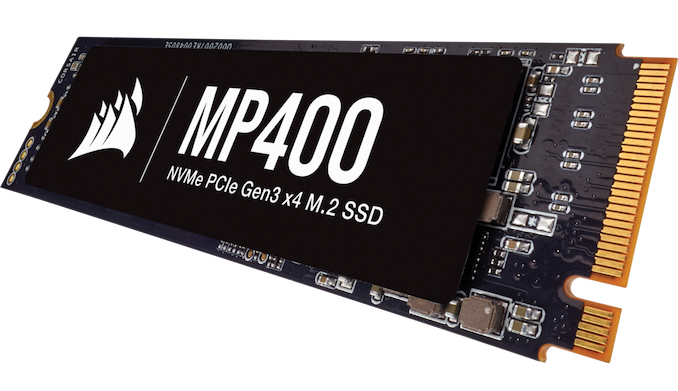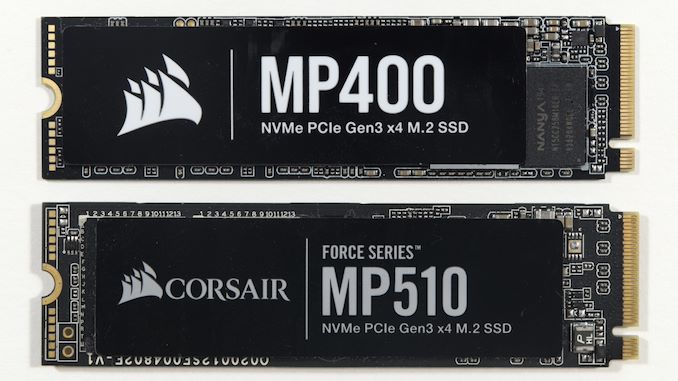The Corsair MP400 1TB QLC NVMe SSD: A Quick Review
by Billy Tallis on December 11, 2020 2:00 PM EST
Following up from our recent look at 8TB QLC SSDs, today we're taking a look at the 1TB Corsair MP400. This is a QLC NVMe SSD using the Phison E12 controller, which puts it a step up from earlier QLC SSDs that used four-channel Silicon Motion controllers. Unlike last week's review of 8TB SSDs, this time we're dealing with a much more affordable capacity of 1TB. At 8TB, many of the downsides of QLC NAND can be overcome by the sheer volume of flash memory, but this 1TB drive falls toward the low end of the QLC SSD capacity range and faces real competition from entry-level drives using TLC NAND.
Corsair MP400
The MP400 is Corsair's answer to Sabrent's Rocket Q and other similar SSDs that have adopted the combination of the Phison E12S controller and QLC NAND. Compared to the Sabrent Rocket Q, Corsair's specifications for the MP400 are a bit more optimistic on performance and a bit lower on the write endurance rating, but we expect the real-world differences between these drives at the same capacity to be insignificant given the near-identical hardware.

Corsair MP400 1TB (QLC) and the Corsair Force MP510 (TLC)
Sabrent's Rocket Q product line covers capacities from 500GB to 8TB. Corsair drops the 500GB option, which is very reasonable: we consider 1TB to be the bare minimum for a QLC drive to make sense. That's especially true of these drives that use an 8-channel Phison E12S controller, half of which goes unused on a 500GB QLC model. Mushkin's recently announced ALPHA series goes even further and will only offer 4TB and 8TB options.
| Corsair MP400 Specifications | |||||
| Capacity | 1 TB | 2 TB | 4 TB | 8 TB | |
| Form Factor | M.2 2280 PCIe 3 x4 | ||||
| Controller | Phison E12S | ||||
| NAND Flash | Micron 1Tbit 96L 3D QLC | ||||
| Sequential Read (MB/s) | 3480 | ||||
| Sequential Write (MB/s) | 1880 | 3000 | |||
| Random Read IOPS (4kB) | 190k | 380k | 610k | ||
| Random Write IOPS (4kB) | 470k | 560k | 710k | ||
| Power Consumption | 4.0 W | 5.5 W | 6.5 W | 6.5 W | |
| Warranty | 5 years | ||||
| Write Endurance | 200 TB 0.1 DWPD |
400 TB 0.1 DWPD |
800 TB 0.1 DWPD |
1600 TB 0.1 DWPD |
|
| Current Retail Prices | $114.99 (11¢/GB) |
$244.99 (12¢/GB) |
$662.00 (17¢/GB) |
$1498.00 (19¢/GB) |
|
The 1TB capacity point is currently the volume spot in the consumer SSD market for QLC, with the most competition and the best prices on a per-GB basis. QLC SSDs have made multi-TB SSDs more affordable, but 2TB and larger drives still tend to carry a premium. In the entry-level NVMe market segment, there's overlap at 1TB between DRAMless TLC designs and QLC with DRAM designs, two markedly different strategies for cutting costs. There are thankfully only a handful of DRAMless QLC NVMe drives that combine both weaknesses. There are also a few relatively budget-oriented TLC SSDs with DRAM that hit low price points using cheaper 4-channel controllers.

Corsair MP400 1TB (QLC, Top) and the Corsair Force MP510 (TLC, Bottom)
Each of these approaches to an entry-level NVMe SSD (QLC+DRAM vs TLC without DRAM) comes with its own typical weaknesses, and some advantages. DRAMless SSDs will suffer under workloads with heavy random IO, but where they do offer decent performance they tend to have very good power efficiency - not having to power any external DRAM chips helps. QLC SSDs suffer most during sustained writes, and are very heavily reliant on their SLC caches. Smaller drives have smaller SLC caches, so it will be much easier to overflow that write cache on this 1TB MP400 than on the larger variants. Most QLC and TLC drives tend to use SLC caches, but QLC drives also tend to use the largest SLC cache sizes possible, which exacerbates the performance problems once the cache is full - there's little or no empty flash left that could be written to directly as QLC, and until the drive can catch a break, further writes will require compacting data from the SLC cache into QLC blocks to free up space.
Most drives using 4-channel controllers have notably limited throughput. SK hynix was first to market with a 4-channel drive that could saturate PCIe 3 x4 (with TLC NAND), and that Gold P31 is priced more like a high-end drive. Silicon Motion has introduced a 4-channel Gen4 controller that is also more than fast enough for a Gen3 x4 interface, but it also is not yet cheap enough for entry-level drives. So for now, the 8-channel Phison E12 controller is the best option for high-capacity QLC SSDs to improve performance.
This review has two main points of comparison for our 1TB Corsair MP400 sample: the 8TB Sabrent Rocket Q we recently reviewed is the most similar, and lets us see how this Phison E12+QLC design scales down to smaller capacities. We also have results for several other 1TB entry-level SSDs, including DRAMless TLC models from Mushkin and Toshiba/Kioxia, and earlier QLC NVMe drives from Intel and Crucial. Unfortunately, we were unable to secure the Western Digital WD Blue SN550 in time for this review; it generally seems to be the best DRAMless TLC drive on the market, and would offer the toughest competition against QLC designs at this 1TB capacity point.
Read on for more analysis.
| AnandTech 2018 Consumer SSD Testbed | |
| CPU | Intel Xeon E3 1240 v5 |
| Motherboard | ASRock Fatal1ty E3V5 Performance Gaming/OC |
| Chipset | Intel C232 |
| Memory | 4x 8GB G.SKILL Ripjaws DDR4-2400 CL15 |
| Graphics | AMD Radeon HD 5450, 1920x1200@60Hz |
| Software | Windows 10 x64, version 1709 |
| Linux kernel version 4.14, fio version 3.6 | |
| Spectre/Meltdown microcode and OS patches current as of May 2018 | |
- Thanks to Intel for the Xeon E3 1240 v5 CPU
- Thanks to ASRock for the E3V5 Performance Gaming/OC
- Thanks to G.SKILL for the Ripjaws DDR4-2400 RAM
- Thanks to Corsair for the RM750 power supply, Carbide 200R case, and Hydro H60 CPU cooler
- Thanks to Quarch for the HD Programmable Power Module and accessories
- Thanks to StarTech for providing a RK2236BKF 22U rack cabinet.














75 Comments
View All Comments
Spunjji - Monday, December 14, 2020 - link
This is the only one of the anti-QLC tropes I see routinely rolling around this comment section that I 100% unequivocally agree with.A quick scan through a certain UK retailer shows the cheapest 1TB drive is the Intel 665p at £89, with the cheapest (relatively crappy) TLC drive at £96 and a WD Blue at £103. Worse still, at the 2TB level the positions flip and the WD Blue is *cheaper*.
At the 1TB level, even though I know objectively that the 665p would be fine for my purposes I'd still be tempted to pay the £14 extra for the Blue. If the difference were £25 or more, I wouldn't.
GeoffreyA - Monday, December 14, 2020 - link
It's as if margarine were suddenly the same price as butter, or quite close, and the makers, exterting their marketing force, succeeded (almost succeeded) in blurring the distinction between the two.It would be nice if somebody did a giant endurance experiment, finding out exactly where these QLC drives stand, like the one Techreport tackled in 2015, writing an horrific number of TBs till the drives "breathed their last." There will be surprises.
Oxford Guy - Monday, December 14, 2020 - link
They will succeed. Getting everyone to go to a small form factor was very helpful, along with, apparently, not producing TLC in 1024Gbit dies.Margarine was superior to butter back in the day, remember? Superior partially hydrogenated technology. Because they said so.
Oxford Guy - Monday, December 14, 2020 - link
Not the best comparison, though – since butter was still widely available for reasonable prices.QLC, by contrast, is intended to ruin the economy of scale of TLC. We could find farmers with butter churns pretty easily. Not so easy to find small-scale TLC foundries for the peasantry.
GeoffreyA - Tuesday, December 15, 2020 - link
"Margarine was superior to butter back in the day, remember? Superior partially hydrogenated technology. Because they said so."Nice one.
Oxford Guy - Monday, December 14, 2020 - link
QLC doesn't need "tropes" any more than it needs cheerleading.Reality is that 16 voltage states is more problematic than 8 and fewer.
boredsysadmin - Monday, December 14, 2020 - link
I 100% agree with @kpb321I am also surprised that SK Hynix Gold P31 didn't make the last page budget consumer NVMe SSDs. MP400 1TB costs $114 on amazon, while one of the fastest budget drives in the review, P31 1TB, is currently at $120.60 - Which one you'd buy? I am "puzzled" by QLC drive makers' greed to raise the price per TB on bigger drives. They aren't the first to fill that niche - I expect the opposite - higher drives to be more expensive but priced the same or cheaper per TB.
Drkrieger01 - Friday, December 11, 2020 - link
I love how everyone's up in arms at 'Endurance'. Let me give you some insight on just how much 'endurance' you really need. I build a 'high speed storage' server, 16x 840 Evo 1TB, LSI MegaRaid 9750 16i back in 2014. We've been pounding the piss out of this server for *6* years. Not a single drive has reallocated sectors. I believe we've crossed a few petabytes on some of the drives, even after having to flash firmware updates and re-zero the drives due to the decay issue on the 840 Evo's.I'm sure these new drives will be just fine for the average user.
inighthawki - Friday, December 11, 2020 - link
Let's not forget that most people aren't coming *remotely* close to what you're doing. I bet even most power users would struggle to *consistently* write more than 10-20GB per day average to these drives. Hitting the endurance ratings at these rates would take decades. The SSDs will have been long discarded by that point.Even for the exceptional power user writing 100+GB a day, they would need to consistently do that every day for nearly 6 years to hit the endurance cap on the 1TB model. A user like this will also likely replace these drives within that time frame.
Tomatotech - Friday, December 11, 2020 - link
I have little to no worry about endurance for the vast majority of users even with QLC, and even that problem will go away with 2TB+ QLC.That said, your use is unusual, and the 840s were particularly good drives especially with 1TB. The same usage patterns with 256gb TLC or 512GB QLC might well have seen them wear out. Thankfully we’re past that stage now. However you still had to flash firmware and re-zero the drives, and most people with SSDs nowadays won’t know how to do that.